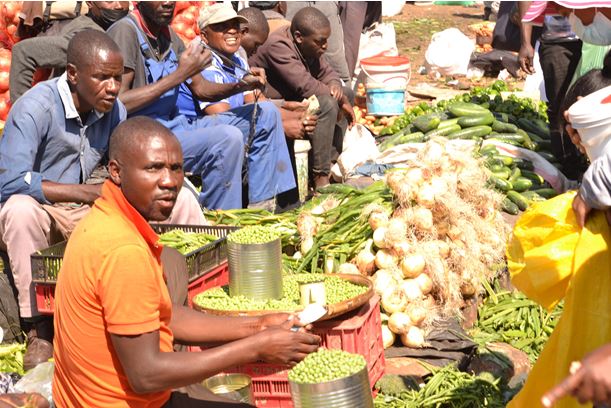By Charles Dhewa
African countries have no shortage of documents on how aggregating agricultural commodities can change lives of farmers and low-income consumers. Some agricultural consultants and development agencies have made a living from advising government departments and farming communities on how to design value chain strategies. Slogans like making markets work for the poor have become common buzzwords across Africa but the poor continue to struggle in marketing their commodities as most of the proposed value chain strategies have remained sensible on paper.
The untapped potential of aggregation
What has become clear is that individual value chains do not change lives as they are too vulnerable to disruptions caused by market failure or geo-political tension like the Russia-Ukraine war. Helping communities to aggregate commodities at local level is a better solution than depending on single value chains. It is through aggregation that food diversity and nutrition security can be secured not promoting an individual commodity like maize or wheat which does not grow in other parts of a country.
Every African country is characterized by diverse food commodities. For instance, like Ethiopia and Uganda, Zimbabwe’s food basket comprises more than 100 agricultural commodities of which more than 90% are traded and distributed through mass markets located in district centres, towns, and cities. Major actors in these markets are traders who operate from stalls allocated by respective local authorities. Of the more than 60 000 agricultural commodity traders in big cities of Zimbabwe, at least 80% are youth and women with no access to formal funding that can enable their businesses to grow. On the other hand, food processors often struggle to get raw materials for processing due to fragmented production and distribution systems in several production zones.
Declining return on investment
Without blaming climate change for the poor performance of the food systems, overall return on investment in agriculture has been declining across Africa every year due to:
- Disorganized and uncoordinated production and distribution systems.
- A mismatch between commodity production/supply and demand/consumption patterns.
- Information asymmetry along supply chains– from production to markets to consumers.
- Lack of investments in agriculture mass markets and distribution systems (roads & transport).
- Lack of alternative markets and business models for raw agriculture commodities.
Aggregation can only be a solution to some of these challenges if implemented in the following sequence:
- Mapping and analysing production/supply areas of selected value chains and needs of various markets (formal & informal).
- Presentation of findings to key agriculture actors and building consensus.
- Setting up production and market-based aggregation models and supporting systems.
- Capacitating production, logistics, and market ecosystems based on identified needs.
- Developing and supporting selected value chains supply corridors– distribution systems.
- Generating and processing agriculture market data to inform production.
In most cases, huge demand for agricultural commodities creates a long distribution network starting from the level of farmers/producers, intermediary traders, to mobile traders/retailers who sell directly to end consumers. For horticulture crops, some have perishable characteristics that necessitate special handling, and short marketing channels to ensure quick distribution processes so that commodities reach consumers on time. A long marketing chain causes a decline in quality, losing weight due to damage to a commodity resulting in both physical and economic losses.
The role of big data and ICTs
In addition to aggregating commodities for the market and food security at both local and national levels, the aggregation model can ride on the proliferation of ICTs to mobilize fluid agricultural data for the benefit of all value chain actors and policy makers. In most African countries, changes in food systems have seen agriculture mass markets becoming the main market option for the majority of farmers in all categories while the role of processing companies and the export market has gone down.
However, the expanding mass market patronized by smallholder farmers has continued to lack data collection and management systems and national support in developing infrastructure. Mass markets have remained independent ecosystems due to the absence of consistent data collection. What policymakers have ignored is the fact that as food moves along the supply chain, it changes hands from government support in the form of government extension services or NGOs involved in agriculture, to private transporters or public transport, to different classes of traders who also take commodities from formal companies to the mass market which are under local authorities. There has to be a robust system for tracking the movement of food including types and volumes of commodities going to agricultural-related SMEs who are now key players in the food system.
Benefits of aggregation business models
Some of the critical benefits associated with aggregating agricultural commodities include:
- Improving the efficiency of agricultural product trading systems.
- Maintaining the availability of agricultural products.
- Stabilizing agricultural commodity prices.
- Improving the welfare of farmers by diversifying their livelihood strategies.
- Equitably and economically serving several distribution nodes within the country.
- Providing broader and more diverse sources of commodities and local products.
- Reducing the cost of trading agricultural commodities which is often considered a waste.
- Taking advantage of available infrastructure to support cross-country as well as regional trading.
- Reducing logistical costs from smallholder farmers as well as costs related to distribution, access to inputs and financial services for supply chain actors.
- Reducing the cost of collecting and disseminating supply chain information.
- Increasing the collective bargaining power of farmers to secure better prices.
- Unlocking the potential of rural resources and improving the village economy through rural industrialization.
- Improving product standardization in accordance with characteristics of products desired by markets and consumers.
- Supporting the natural resources-driven devolution agenda and stimulating national growth including employment creation.
If African governments have resources for only one food systems intervention in 2023, that should be aggregation commodities to stimulate local food production and avert reliance on food imports.
AUTHOR’S CONTACT DETAILS:






